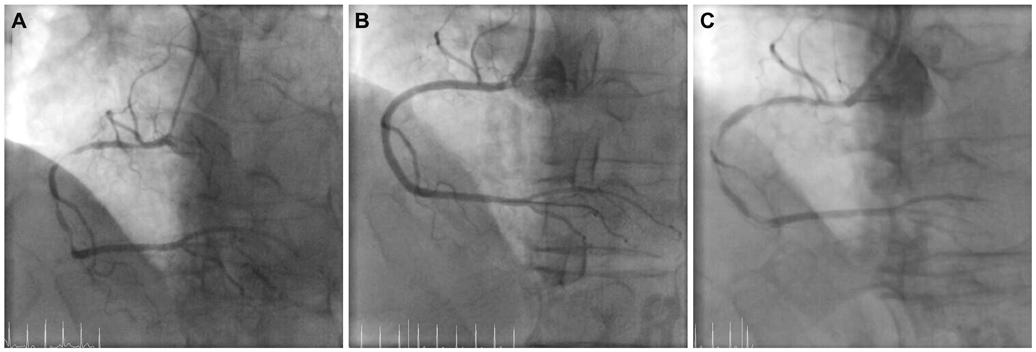Korean Circ J.
2012 Jun;42(6):431-433. 10.4070/kcj.2012.42.6.431.
No-Reflow Phenomenon During Treatment of Coronary In-Stent Restenosis With a Paclitaxel-Coated Balloon Catheter
- Affiliations
-
- 1Department of Internal Medicine, St. Vincent's Hospital, The Catholic University of Korea College of Medicine, Suwon, Korea. cardiomoon@gmail.com
- KMID: 1433865
- DOI: http://doi.org/10.4070/kcj.2012.42.6.431
Abstract
- Drug-eluting balloon (DEB) with angioplasty a paclitaxel-coated balloon catheter is an effective treatment option in patients with in-stent restenosis (ISR) after a drug-eluting stent (DES). We describe a case in which 'no-reflow' phenomenon developed after DEB angioplasty of a DES ISR lesion. Coronary flow was restored after intracoronary administration of nicorandil.
MeSH Terms
Figure
Reference
-
1. Unverdorben M, Vallbracht C, Cremers B, et al. Paclitaxel-coated balloon catheter versus paclitaxel-coated stent for the treatment of coronary in-stent restenosis. Circulation. 2009. 119:2986–2994.2. Scheller B, Speck U, Abramjuk C, Bernhardt U, Böhm M, Nickenig G. Paclitaxel balloon coating, a novel method for prevention and therapy of restenosis. Circulation. 2004. 110:810–814.3. Scheller B, Hehrlein C, Bocksch W, et al. Treatment of coronary in-stent restenosis with a paclitaxel-coated balloon catheter. N Engl J Med. 2006. 355:2113–2124.4. Unverdorben M, Kleber FX, Heuer H, et al. Treatment of small coronary arteries with a paclitaxel-coated balloon catheter. Clin Res Cardiol. 2010. 99:165–174.5. Niccoli G, Burzotta F, Galiuto L, Crea F. Myocardial no-reflow in humans. J Am Coll Cardiol. 2009. 54:281–292.6. Rezkalla SH, Kloner RA. Coronary no-reflow phenomenon: from the experimental laboratory to the cardiac catheterization laboratory. Catheter Cardiovasc Interv. 2008. 72:950–957.7. Nakamura T, Brott BC, Brants I, et al. Vasomotor function after paclitaxel-coated balloon post-dilation in porcine coronary stent model. JACC Cardiovasc Interv. 2011. 4:247–255.8. Skalpe IO. The toxicity of non-ionic water-soluble monomeric and dimeric contrast media in selective vertebral angiography: an experimental study in rabbits. Neuroradiology. 1983. 24:219–223.9. Limbruno U, Petronio AS, Amoroso G, et al. The impact of coronary artery disease on the coronary vasomotor response to nonionic contrast media. Circulation. 2000. 101:491–497.10. Sakata Y, Kodama K, Ishikura F, et al. Disappearance of the 'no-reflow' phenomenon after adjunctive intracoronary administration of nicorandil in a patient with acute myocardial infarction. Jpn Circ J. 1997. 61:455–458.11. Iwakura K, Ito H, Okamura A, et al. Nicorandil treatment in patients with acute myocardial infarction: a meta-analysis. Circ J. 2009. 73:925–931.12. Tsubokawa A, Ueda K, Sakamoto H, Iwase T, Tamaki S. Effect of intracoronary nicorandil administration on preventing no-reflow/slow flow phenomenon during rotational atherectomy. Circ J. 2002. 66:1119–1123.
- Full Text Links
- Actions
-
Cited
- CITED
-
- Close
- Share
- Similar articles
-
- No-Reflow Phoenomenon by Intracoronary Thrombus in Acute Myocardial Infarction
- Risk of Stent Stenosis after Implanting a First-Generation Drug-Eluting Stent and Drug Balloon Angioplasty
- Percutaneous Coronary Intervention in Ischemic Heart Disease
- Coronary Flow Doppler Profile in No-Reflex Phenomenon after Direct PTCA in Acute Myocardial Infarction
- Meaning of serum antibody to Chlamydia pneumoniae in patients with restenosis after coronary balloon angioplasty or stent insertion



